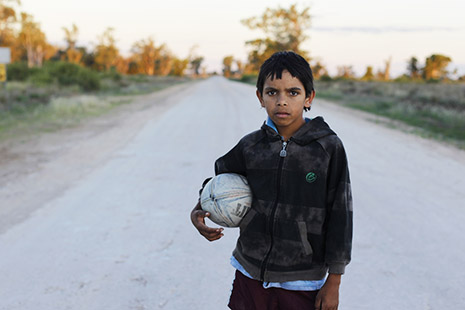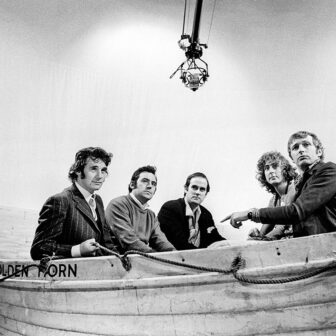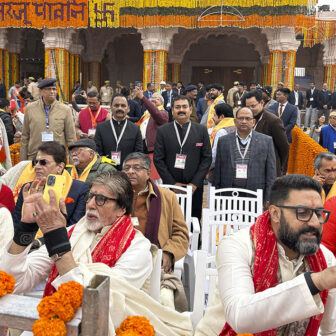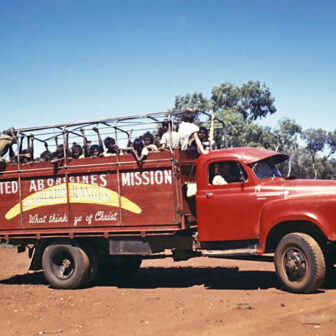TWO of the best films made in Australia, in this and most other years, are now finishing short runs at marginal sites in our cities. Many who care for cinema per se, and others who see these stories as central in the landscape, are likely to miss them altogether. They can be sought on DVD, but they repay the big-screen impact and should be allowed more of it, with more talk around them, more energetic promotion.
One of these is Ivan Sen’s Toomelah, a close-to-real-life story about a very real place, one linked to this director’s early life and family, an Aboriginal community in northern New South Wales. Its generalised depression and poverty could be the material of visual clichés; they’re not, because of the life in the performances, the conviction in the transmission of place. With trees and bush, twisting dirt roads and river, prowling cars, litter, desolate houses, indolence, the film builds Toomelah for the audience, and those who watch it in a setting of urban privilege must know they’re visiting foreign country. We see young Daniel (Daniel Connors) being kicked out of the little one-teacher school for playing up; his father has been missing in action for years, his mother sits around getting stoned, even sending off the child to collect her next stick. There’s a worn-out grandmother, who stares into space, smoking; but she cares about the ten-year-old and asks him what he’s going to do with himself. “I don’t know,” says Daniel. “What can I do?” I think that’s his longest line of dialogue: this film contains many silences, and Daniel has a highly eloquent way of looking back at his questioners; academic theorists of the cinematic gaze could have a real party with this one.
To the child’s question, some of the big men of Toomelah offer misguided answers; Daniel badly needs different grown-ups around him, different men especially. For the young and directionless, this is the kind of place where suicide is a truly possible option. But there are cracks of light, doors that open just enough to allow us some hope for this observant kid and his kind. Apart from a couple of cops seen from behind in middle distance, the one white person on the scene – and he’s barely glimpsed – is the schoolteacher; but he’s really trying. He has made a big chart for the kids, one that shows invasion and dispossession at the centre of the history they need to know. There’s an open possibility of learning why they’re here.
It might sound like the kind of film generally called “confronting.” Curiously, because of the wholeness and steadiness of Ivan Sen’s directorial vision, and its strand of comedy, it’s not. As a township Toomelah exerts its own normality, and that includes the mother who keeps her house in order and pulls her boy into line and the little girlfriend who hopes Daniel will come back to school. The invitation to the audience is to accept this world as a continuing part of the Australia we hold in our imaginations; not a problem to be fixed from outside (“intervention”!) but a place where people, deserving much better as they do, have agency. That was demonstrated a few weeks ago when Ivan Sen screened the film on a sports field in Toomelah for its own subjects; he found the responses extraordinary, far beyond what might have been expected, in the expression of lives, selves, places and identities validated, made real to their owners as never before. For such a community, there’s nothing like recognition.
Having thus worked as a cast, the Toomelah people want to go on working – in films. Sen, now partly based in Hong Kong, has said that he’ll go back, set up workshops and help them. Anything could happen, and probably will. Meanwhile, the scandal for us is that such a film couldn’t be given a mainstream outlet, with full-on mainstream promotion; it should be seen by everyone who saw Samson and Delilah, and for that matter by everyone who doesn’t know the Toomelahs are there.
IN SMALLER cinemas you might still catch one stunning documentary, The Tall Man. This was written and directed by Tony Krawitz, from Chloe Hooper’s splendid book on the struggle for justice by members of the Palm Island community, after the death in custody of Cameron Doomadgee in November 2004. Through successive inquests and inquiries, the story became widely known: Doomadgee, a fit thirty-six-year-old, was walking the street singing – “happy-go-lucky,” several witnesses said, as he generally was – when he exchanged a few words, swear-words included, with Sergeant Christopher Hurley, who arrested him and took him in the police wagon to the island’s lockup; when they arrived, Doomadgee punched him. Inside, according to one witness, Hurley – a very big man, two metres tall and 115 kilos – beat Doomadgee aggressively before leaving him in a cell; forty-five minutes later the prisoner was found dead, with injuries like those which could have followed a car crash at high speed – bruising, broken ribs, a ruptured liver and massive internal bleeding. If Hurley’s blows didn’t kill him, no one can find out what did. The coronial inquiry found the officer culpable; the police and their union were outraged; after another inquest, the director of public prosecutions exonerated Hurley. After massive public demonstrations, then-premier Peter Beattie intervened. Hurley was charged with manslaughter, and a trial took place – without, however, one particular Aboriginal witness and his crucial evidence. The sergeant was found not guilty; he is now serving in the force on the Gold Coast.
Noby Clay, the featherweight boxing champion whose story was told in Boxing for Palm Island (part of the 2010 Message Sticks program) is among the storytellers, with Cameron Doomadgee’s sisters and partner, Tracy, who talks of his lightness of heart; she says that he could always lift the spirits of the people around him. Doomadgee’s teenage son Eric speaks about his father’s strength, and his teaching about strength. By the end of the film, we know that Eric has killed himself.
Andrew Boe, the lawyer working pro bono for the community, Chloe Hooper herself, and the journalist Tony Koch, working for the Australian, each give analyses. They are the detectives who have come in from elsewhere; now the story clearly owns them, and they can’t let go until their work for it is done. Andrew Boe says that he doesn’t believe racism was involved, but at that point, he seems to forget that racism is only partly a matter of personal attitudes; it’s bound into social structures, in histories and in the way they are told.
The case was complicated by Hurley’s impressive record of service in other Aboriginal communities, like Burketown on the Gulf, where he set up sports programs for the kids, took them camping, and involved himself busily in township projects. Murrandoo Yanner, of the Carpentaria Land Council, is a highly articulate and insightful commentator on the Burketown chapter, and here he’s a fair comedian as well. He speaks of Hurley as the only copper who’d come as a welcome visitor to his house; as a man who strove hard to recognise and deal with his own racism; as one with a lot of good in him, and also with “a dark side.” It seems likely that in a few terrible moments on Palm Island the darker elements surged up and overwhelmed the rest. In consequence, we look at the huge rallies that filled streets and squares in Townsville, then in Brisbane, some held to protest for justice on the island, and several solid thousands marching for the police.
The film doesn’t take up everything explored in Chloe Hooper’s book; for example, the intense commitment to Christian faith on the part of Elizabeth Doomadgee, or the details of the trial. It could be seen as conventional documentary, made of talking heads and scenic images; but the yield is clarity, energy, purpose. If there’s a dimension of poetry, it comes out of the place, with its compelling beauty held in tension with the knowledge of its history – a dumping ground for the unwanted, an accidental community made of people from differing tribal groups, belief systems and languages. There are also their ways of finding everyday happiness – children and grown-ups alike, splashing and fishing off the beaches, riding the island’s wild horses. There’s also an open-eyed recognition that this story is unfinished, and likely to remain so. As with Toomelah, it’s part of where we are.
JONATHAN Teplitzky’s third feature, Burning Man, has been rather over-praised. Critical questions jump out to be dealt with: how much has the response to do with the surface dazzle of Teplitzky’s style, and how much with the integration of style and story? For all the showy tangling of timelines around the central melodrama, the story is a very simple one. Two young people fall in love, marry and have a child; when that interesting small boy is eight, disaster strikes and must be dealt with, well and badly. With brilliant editing by Martin Connor, and athletic cinematography by Garry Phillips, Teplitzky fractures the tale into kaleidoscopic fragments, so that the audience must allow them to come together. When they do, the film makes considerable sense of the anger and craziness that can go with a major bereavement. We meet Tom (Matthew Goode) in an unforgivably destructive moment, tearing up his small son’s birthday party; then, as the pieces fall together, and coherence builds, there’s more to think about. Tom is manifestly young for his age (thirty-fiveish); all we know about him is that he’s an English immigrant chef, who has landed a place on Sydney’s eastern beaches. Nothing is given of the past, of the other country; the child in this story is Oscar, who is performed with fine complexity by Jack Heanly, and we get a study of the disquieting way in which such a child has to take the adult’s role in a family disordered by illness and death. While Tom is surrounded by women who want to sort him out and (mostly) bed him, Oscar is inevitably the centre of the audience’s hope and dread.
The sex scenes don’t do much for the story – perhaps the intended point is in their very banality; but the settings, in the frantic restaurant kitchen, the house, cafe, beaches, are expressively crowded and detailed. As far as it goes, the film is carried by Teplitzky’s own sharp script and by the performances; Matthew Goode’s, with Bojana Novakovic, Essie Davis, Rachel Griffiths and Kerry Fox among others around him. The pervasive music is by Lisa Gerrard, whose work I have greatly admired since Balibo; this time the score is rather too soulful, as though Tom is being confirmed in self-pity. But then this is melodrama; if the family is torn, the family must be mended. The music is there to remind us, as though we were likely to forget. •





